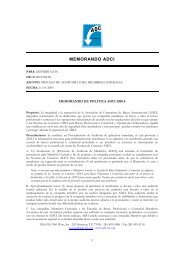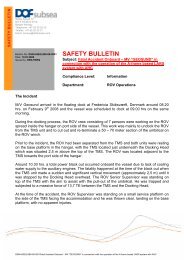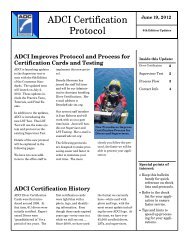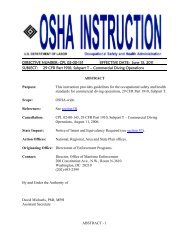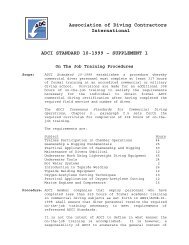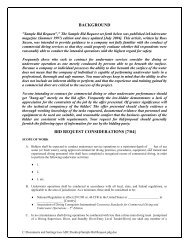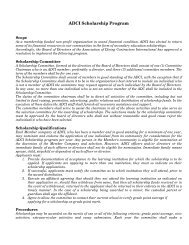SUPERLITE HELMET REMOVAL12.pdf - Association of Diving ...
SUPERLITE HELMET REMOVAL12.pdf - Association of Diving ...
SUPERLITE HELMET REMOVAL12.pdf - Association of Diving ...
You also want an ePaper? Increase the reach of your titles
YUMPU automatically turns print PDFs into web optimized ePapers that Google loves.
ASSOCIATION OF DIVING CONTRACTORS<br />
INTERNATIONAL<br />
1
ASSOCIATION OF DIVING<br />
CONTRACTORS INTERNATIONAL<br />
A non-pr<strong>of</strong>it, industry trade association<br />
established to promote safety, communication and<br />
education throughout the commercial diving and<br />
underwater industry.<br />
2
EMERGENCY REMOVAL<br />
OF<br />
DIVING SYSTEMS INTERNATIONAL<br />
(DSI)<br />
<strong>SUPERLITE</strong><br />
DIVING <strong>HELMET</strong>S<br />
© <strong>Association</strong> <strong>of</strong> <strong>Diving</strong> Contractors International June 2000<br />
3
Commercial diving helmets are generally<br />
designed and configured to furnish a high degree<br />
<strong>of</strong> protection to the diver's head while in the<br />
water. However, by the very nature <strong>of</strong> the<br />
design considerations, these helmets can be very<br />
unstable when the wearer has suffered a neck<br />
injury or loss <strong>of</strong> motor control when in an<br />
unconscious condition.<br />
4
Standard emergency medical protocols are<br />
available outlining the first aid procedures to<br />
be undertaken in cases <strong>of</strong> suspected head or<br />
neck injuries. These same spinal injury<br />
considerations also apply to a diver who<br />
surfaces in an unconscious or non-responsive<br />
condition, or to a fully dressed diver who has<br />
slipped and fallen on deck and may be injured<br />
5
Recognizing this fact, the <strong>Association</strong> <strong>of</strong><br />
<strong>Diving</strong> Contractors International, <strong>Diving</strong><br />
Systems International, representatives <strong>of</strong> the<br />
United States Navy, commercial diving<br />
companies and representatives <strong>of</strong> commercial<br />
diving schools working together as a team<br />
have developed procedures for the removal<br />
<strong>of</strong> SuperLite helmets in a manner intended to<br />
minimize the possibility <strong>of</strong> further injury to<br />
the diver's neck.<br />
6
These procedures also furnish a removal<br />
protocol consistent with surface interval<br />
considerations related to decompression<br />
treatment <strong>of</strong> a diver in a recompression<br />
chamber. Users <strong>of</strong> these helmets should<br />
review and practice these procedures to ensure<br />
that all dive team personnel are competent in<br />
emergency removal <strong>of</strong> the helmets.<br />
7
The following procedures only address the<br />
referenced models <strong>of</strong> SuperLite helmets and<br />
were developed in cooperation with <strong>Diving</strong><br />
Systems International and may not apply to<br />
other helmet types.<br />
8
Manufacturers <strong>of</strong> specific helmets should be<br />
contacted for safe removal procedures <strong>of</strong> their<br />
helmets in suspected neck (cervical spine [cspine])<br />
injuries. Likewise, manufacturers <strong>of</strong><br />
helmets other than those identified below are<br />
encouraged to ensure that a procedure is<br />
developed and promulgated to permit safe<br />
removal in emergency circumstances and,<br />
consistent with the time lines necessary to<br />
place an injured diver in a recompression<br />
chamber.<br />
9
These procedures apply to the following<br />
helmet models:<br />
• SuperLite 17A/B<br />
• SuperLite 17C<br />
• Military Mark 21 ( SuperLite 17B/NS)<br />
• Superlite 27<br />
• Superlite 17K<br />
10
CAUTION<br />
These procedures only address the<br />
removal <strong>of</strong> the helmet while the<br />
diver is on deck.<br />
11
The intent <strong>of</strong> these procedures is not to furnish<br />
the reader with instruction in the safe methods <strong>of</strong><br />
removing the injured diver from the water or in<br />
appropriate first aid and spinal immobilization<br />
procedures. All reasonable precautions should<br />
be taken to safely remove the injured diver from<br />
the water while attempting to stabilize the head<br />
and neck under the given circumstances.<br />
12
The primary consideration should be to prevent<br />
further harm! Maintain a "neutral" position <strong>of</strong><br />
the injured diver's head and neck at all times.<br />
Maintaining a "neutral position" only implies<br />
keeping the head and neck as immobile as<br />
possible and not applying any in-line traction.<br />
13
Four preliminary recommendations are presented<br />
as applicable in recovery <strong>of</strong> the injured diver from<br />
the water and removal <strong>of</strong> the helmets:<br />
14
1. A minimum <strong>of</strong> two properly trained people is<br />
required to safely perform the removal <strong>of</strong> the<br />
helmet.<br />
2. Heavy-duty bandage scissors or "paramedic"<br />
shears (trauma shears) are recommended for safe<br />
and efficient removal <strong>of</strong> the helmet, neck dam,<br />
bail-out cylinder backpack harness, weight belt<br />
and diver's suit (wet or dry). Knives should not<br />
be used.<br />
15
3. It is a "judgement call" as to whether to cut or<br />
otherwise remove the bailout cylinder backpack,<br />
harness, weight belt, etc. before or after removing<br />
the helmet. However; indications are that if the<br />
bail-out or reserve breathing gas cylinder is left in<br />
place at the diver's back, it will help to stabilize<br />
the diver's position while the helmet is being<br />
removed, ease the effort <strong>of</strong> the rescuers and<br />
possibly mitigate the effects <strong>of</strong> vessel movement<br />
during the helmet removal procedure.<br />
16
4. The dive team member who initially holds the<br />
injured diver's helmet / head must not assume<br />
any other responsibility during the equipment<br />
removal. His/her sole responsibility MUST be to<br />
solely concentrate on maintaining the neutral<br />
position <strong>of</strong> the diver's head.<br />
17
MODEL 17A/B & MILITARY<br />
MK 21<br />
<strong>HELMET</strong> REMOVAL<br />
18
Have heavy bandage scissors or paramedic shears<br />
(trauma shears) and first aid kit at hand.<br />
19
PARAMEDIC SHEARS<br />
&<br />
FIRST AID KIT<br />
20
Address "A B C s" <strong>of</strong> first aid. AIRWAY –<br />
BREATHING – CIRCULATION. These are<br />
critical to survival and well-being!<br />
21
Maintain "recovery position" <strong>of</strong> the injured diver.<br />
Right side down. The helmet side block<br />
assembly will help to maintain the neutral<br />
position <strong>of</strong> the diver's head. This position will<br />
expose the neck clamp assembly as well as<br />
facilitate secretion removal from the mouth <strong>of</strong> an<br />
unconscious diver. It is emphasized that this<br />
lateral / side positioning is much more stable<br />
than attempting removal with the helmet in the<br />
perpendicular position (diver on his/her back).<br />
22
DIVER IN “RECOVERY” POSITION<br />
Note “bail-out” supporting back while helmet rests on side block<br />
23
Release the umbilical from the diver's harness<br />
and clear it, and any extraneous equipment and<br />
materials that may interfere with the diver's<br />
stabilization and helmet removal effort.<br />
Ascertain that there is sufficient slack in the<br />
umbilical to allow the helmet to be removed<br />
smoothly and moved out <strong>of</strong> the way after<br />
removal. Disconnect reserve gas (bailout) supply<br />
hose.<br />
24
CUT HARNESS CLEAR<br />
25
DISCONNECT BAIL-OUT WHIP<br />
26
"Crack" Steady Flow (Side Block) valve to<br />
provide additional air to diver during<br />
equipment removal procedure.<br />
Ascertain that the Nose Block Device is fully<br />
extended (outward).<br />
27
OPEN (Crack)(<br />
AIR SUPPLY VALVE<br />
28
The dive team member holding the diver's head<br />
(maintaining c-spine alignment) should place<br />
his/her right hand between the yoke/neck ring<br />
assembly and the diver's right shoulder to support<br />
the assembly. The left hand is placed on the left<br />
side <strong>of</strong> the helmet to maintain its position.<br />
29
MAINTAINING c-spine ALIGNMENT<br />
30
The second dive team member opens the neck<br />
clamp assembly and drops the clamp assembly<br />
slightly to clear the rear hinge tab from the<br />
alignment pin. If the suit is mated to the helmet<br />
cut the suit yoke rear hinge tab from the<br />
alignment pin and cut the yoke clear <strong>of</strong> the<br />
diver's neck with the shears.<br />
31
OPEN NECK CLAMP ASSEMBLY<br />
32
CLEAR REAR HINGE TAB<br />
33
Release helmet liner chin strap.<br />
34
The second dive team member then rotates the<br />
helmet forward and down to clear the oral-nasal<br />
mask, the back <strong>of</strong> the helmet rotating <strong>of</strong>f the<br />
diver's head first! The dive team member<br />
maintaining the c-spine position slips his/her<br />
right hand to the right side <strong>of</strong> the diver's head<br />
while moving his/her left hand to the left side <strong>of</strong><br />
the diver's head as the helmet is being removed.<br />
35
ROTATE <strong>HELMET</strong> FORWARD<br />
36
The helmet is then placed in front <strong>of</strong> the diver.<br />
37
MAINTAINING HEAD / c-spine<br />
ALIGNMENT<br />
38
The second dive team member (using the bandage<br />
scissors or shears) then cuts away as much as the<br />
neck dam as accessible, as close as possible to the<br />
neck clamp. This will facilitate clamp removal<br />
with minimal movement <strong>of</strong> the head / neck.<br />
39
CUTTING NECK DAM<br />
40
The second dive team member then lifts the neck<br />
clamp assembly over the diver's head while the<br />
dive team member holding the c-spine position<br />
guides the clamp and maintains the head/neck<br />
position. Move the reserve gas cylinder, weight<br />
belt and all associated equipment clear <strong>of</strong> the diver.<br />
41
LIFT NECK CLAMP ASSEMBLY<br />
42
Reposition the diver on his/her back while<br />
following standard first aid / EMS spine<br />
immobilization procedures.<br />
43
POSITION DIVER FOR<br />
IMMOBILIZATION & FIRST AID<br />
PROCEDURES<br />
44
Using shears, cut the suit neck dam and only as<br />
much <strong>of</strong> the suit as necessary to properly evaluate<br />
the diver for additional injuries. Note that the suit<br />
may provide thermal protection for the injured diver<br />
and complete removal may not be indicated.<br />
45
CUT SUIT AS NECESSARY<br />
46
MODEL<br />
27A/B, 17C & 17K<br />
<strong>HELMET</strong> REMOVAL<br />
47
NOTE: This procedure is predicated on the<br />
neck ring swing catch update kit having been<br />
installed.<br />
48
Have heavy bandage scissors or paramedic shears<br />
(trauma shears) and first aid kit at hand.<br />
49
PARAMEDIC SHEARS<br />
&<br />
FIRST AID KIT<br />
50
Address "A B C s" <strong>of</strong> first aid. AIRWAY –<br />
BREATHING – CIRCULATION. These are<br />
critical to survival and well-being!<br />
51
Maintain "recovery position" <strong>of</strong> the injured diver.<br />
Right side down. The helmet side block<br />
assembly will help to maintain the neutral<br />
position <strong>of</strong> the diver's head. This position will<br />
expose the neck clamp assembly as well as<br />
facilitate secretion removal from the mouth <strong>of</strong> an<br />
unconscious diver. It is emphasized that this<br />
lateral / side positioning is much more stable<br />
than attempting removal with the helmet in the<br />
perpendicular position (diver on his/her back).<br />
52
DIVER IN “RECOVERY” POSITION<br />
Note “bail-out” supporting back while helmet rests on side block<br />
53
DIVER IN “RECOVERY” POSITION<br />
54
Release the umbilical from the diver's harness<br />
and clear it, and any extraneous equipment and<br />
materials that may interfere with the diver's<br />
stabilization and helmet removal effort.<br />
Ascertain that there is sufficient slack in the<br />
umbilical to allow the helmet to be removed<br />
smoothly and moved out <strong>of</strong> the way after<br />
removal. Disconnect reserve gas (bailout) supply<br />
hose.<br />
55
"Crack" Steady Flow (Side Block) valve to<br />
provide additional air to diver during<br />
equipment removal procedure.<br />
Ascertain that the Nose Block Device is fully<br />
extended (outward).<br />
56
OPEN (Crack) AIR SUPPLY VALVE<br />
57
The dive team member holding the diver's head<br />
(maintaining c-spine alignment) should place<br />
his/her right hand between the yoke/neck ring<br />
assembly and the diver's right shoulder to support<br />
the assembly. The left hand is placed on the left<br />
side <strong>of</strong> the helmet to maintain its position.<br />
58
MAINTAINING HEAD/C-SPINE<br />
POSITION<br />
59
The second dive team member then pulls and<br />
releases the two (2) pull pins releasing the locking<br />
collar.<br />
60
RELEASE (2) PULL-PINS<br />
61
"OPEN" Steady Flow (Side Block) valve<br />
sufficiently to provide an "overpressure" inside the<br />
helmet. This overpressure will aid in the removal<br />
<strong>of</strong> the neck clamp assembly by pneumatically<br />
assisting its removal from the helmet. The Neck<br />
Dam Swing Catch must be manually opened at<br />
this time to allow the neck dam assembly to be<br />
unsealed from the helmet.<br />
62
OVERPRESSURIZE <strong>HELMET</strong> TO<br />
RELEASE NECK DAM<br />
63
Carefully pull the neck dam assembly down and out<br />
<strong>of</strong> the helmet.<br />
64
The dive team member maintaining the c-spine /<br />
head position adjusts his/her right hand to allow<br />
the neck dam assembly to clear the helmet.<br />
65
The second dive team member then rotates the<br />
helmet forward, up, and then rotate back to clear<br />
the oral-nasal mask and the nose block device. The<br />
dive team member maintaining the c-spine position<br />
slips his/her right hand to the right side <strong>of</strong> the<br />
diver's head while moving his/her left hand to the<br />
left side <strong>of</strong> the diver's head as the helmet is being<br />
removed.<br />
66
ROLL <strong>HELMET</strong> FORWARD<br />
then<br />
BACK<br />
67
The second dive team member pulls the collar<br />
clear <strong>of</strong> the back <strong>of</strong> the diver's neck.<br />
68
The helmet is then placed in front <strong>of</strong> the diver.<br />
69
PLACE HAT CLEAR OF DIVER<br />
70
Release chin strap at the neck ring.<br />
71
The second dive team member (using the bandage<br />
scissors or shears) then cuts as much as the neck<br />
dam as accessible, as close as possible to the neck<br />
ring. This will facilitate removal <strong>of</strong> the neck ring<br />
with minimal movement <strong>of</strong> the head / neck.<br />
72
CUTTING NECK DAM<br />
73
The second dive team member then lifts the neck<br />
ring assembly over the diver's head while the dive<br />
team member holding the c-spine position guides<br />
the ring and maintains the head/neck position.<br />
Lift the ring assembly clear <strong>of</strong> the diver's head.<br />
74
Move the bailout cylinder, weight belt and all<br />
associated equipment clear <strong>of</strong> the diver.<br />
75
Reposition the diver on his/her back while<br />
following standard first aid / EMS spine<br />
immobilization procedures.<br />
76
POSITION DIVER FOR<br />
IMMOBILIZATION & FIRST AID<br />
PROCEDURES<br />
77
Using paramedic shears or scissors, cut the suit<br />
neck dam and as much <strong>of</strong> the suit as necessary to<br />
properly evaluate the diver for additional injuries.<br />
Note that the suit may provide thermal protection<br />
for the injured diver and complete removal may<br />
not be indicated.<br />
78
CUT SUIT AS NECESSARY<br />
79
In conclusion, these procedures are only<br />
guidelines to be followed in a situation where<br />
an injured diver’s helmet needs to be removed.<br />
Ultimately, the responsibility to see that further<br />
harm is not done to the injured diver lies with<br />
those assisting him/her. Each situation may be<br />
different and these differences need to be taken<br />
into consideration when removing the injured<br />
diver’s gear and helmet.<br />
80


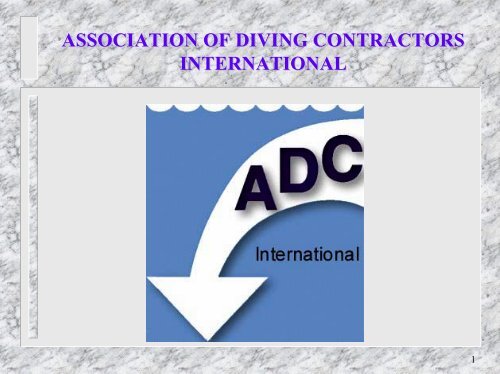
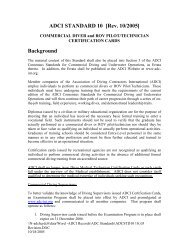
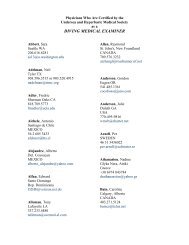
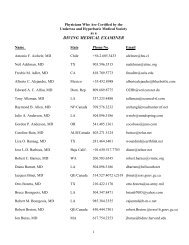
![SOLICITUD MEMBRESIA ASOCIADO [Rev 06/08] - Association of ...](https://img.yumpu.com/48291988/1/190x245/solicitud-membresia-asociado-rev-06-08-association-of-.jpg?quality=85)

